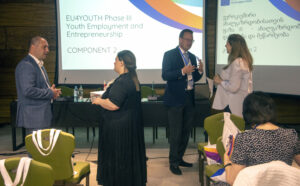
EU4Youth: Youth Employment and Entrepreneurship
Project Description
The key components include the following:
• Skill development and capacity building for civil servants and not only;
• Development of inter-sectoral interaction and cooperation between public authorities and the establishment of sustainable interaction networks between Public Employment Services;
• Informing and raising awareness of young people on decent work standards;
• Piloting certain elements of the Youth Guarantee scheme; working towards validation and certification of skills acquired through non-formal education.
The Programme provides both classic packages of capacity building activities (trainings, courses, etc.) for civil servants and innovative activities towards the development of active labour market measures for unemployed young people, NEETs, and disadvantaged youth.
Specific Objective
The Project is intended as an instrument to assist all the countries of the Eastern Partnership to support constructive and mutually compatible youth employment field.
The project aims to achieve two main goals:
1. Building cross-sector interaction and cooperation among the three institutional branches: public, private, and nongovernmental institutions.
2. Professional development of employees of public authorities (Public Employment Service and other authorities, which prioritize the issues of youth employment and job placement).
Expected Results
Enhanced capacity for stakeholders for active labour market policies developments and evidence based employment policy design;
Massive information campaigned and knowledge sharing on youth employment policies, labour legislation, youth rights and standards;
Piloted Youth Guarantee-type measures integrated into the public youth employment policy;
Legislative and structural changes and amendments for better jobs and recognition of skills acquired through non-formal and informal learning.
Project documents
Project map
Photo gallery
Stories
PROJECT DETAILS
More campaign pages:
Interested in the latest news and opportunities?
This website is managed by the EU-funded Regional Communication Programme for the Eastern Neighbourhood ('EU NEIGHBOURS east’), which complements and supports the communication of the Delegations of the European Union in the Eastern partner countries, and works under the guidance of the European Commission’s Directorate-General for Neighbourhood Policy and Enlargement Negotiations, and the European External Action Service. EU NEIGHBOURS east is implemented by a GOPA PACE-led consortium. It is part of the larger Neighbourhood Communication Programme (2020-2024) for the EU's Eastern and Southern Neighbourhood, which also includes 'EU NEIGHBOURS south’ project that runs the EU Neighbours portal.

The information on this site is subject to a Disclaimer and Protection of personal data. © European Union,




